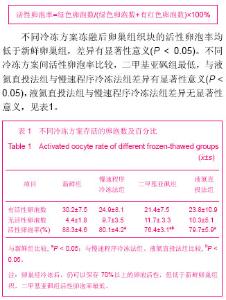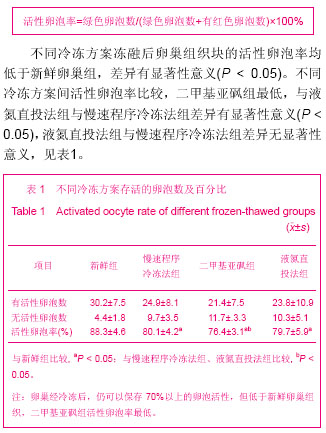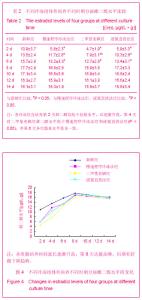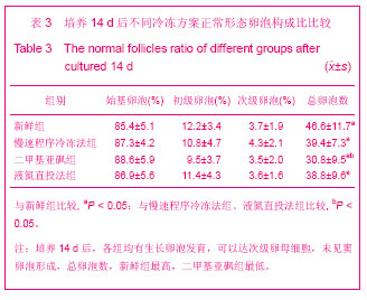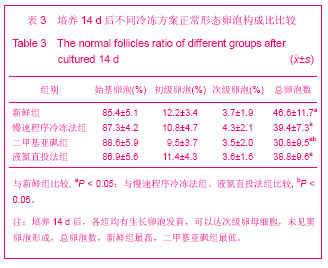| [1] Oktay K, Buyuk E. Ovarian transplantation in humans : indications , techniques and the risk of reseeding cancer. Eur Obstet Gynecol Reprod Biol. 2004;113[Suppl 1] :S45-47.[2] Anderson RA, Wallace WH, Baird DT.Ovarian cryopreservation for fertility preservation: indications and outcomes. Reproduction. 2008;136(6):681-689. [3] Jakimiuk AJ, Fritz A. Endrynol Pol.Ovarian tissue cryopreservation as a perspective for fertility preservation. Endokrynol Pol. 2005;56(6):998-1001.[4] Jakimiuk AJ, Grzybowski W. Ovarian tissue preservation, present and clinical perspectives. Gynecol Endocrinol. 2007; 23(2):87-93.[5] Donnez J, Dolmans MM .Cryopreservation and transplantation of ovarian tissue. Clin Obstet Gynecol. 2010; 53(4):787-796.[6] 陈乐真.妇产科诊断病理学[M].第2版,北京:人民军医出版社社,2010.[7] Cook DA,Edgar DH,Stern C. Effect of cooling rate and dehydration regimen on histological appearance of human ovarian cortex following cryopreservation in PROH. Hum Reprod. 1999;14 (8):2061-2068.[8] Hasegawa A, Hamamda Y, Mehandjiev T, et al. In vitro growth and maturation as well as fertilization of mouse preantral oocytes from vitrified ovaries. Fertil Steril. 2004;81(Suppl 1): 824-830. [9] Isachenko E,Isachenko V,Rahimi G,et al. Cryopreservation of human ovarian tissue by direct plunging into liquid nitrogen. Eur J Obstet Gynecol Reprod Biol. 2003;108: 186-193.[10] Maltaris T, Dragonas C, Hoffmann I, et al.Simple prediction of the survival of follicles in cryopreserved human ovarian tissue. Reprod Dev. 2006 ;52(4):577-682.[11] Oktay K, Economos K, Kan M, et al. Endocrine function and oocyte retrieval after autologous transplantation of ovarian cortical strips to the forearm. JAMA. 2001;286 (12):1490- 1493.[12] Schnorr J, Oehninger S, Toner J, et al. Functional studies of subcutaneous ovarian transplants in human primates : steroidogenesis, endometrial development, ovulation, menstrual patterns and gamete morphology. Hum Reprod. 2002;17(3):612-619.[13] Lee DM , Yeoman RR , Battaglia DE , et al. Live birth after ovaran tissue transplant. Nature. 2004;428:137-138.[14] Donnez J, Dolmans MM, Demylle D, et al. Live birth after orthotopic transplantation of cryopreserved ovarian tissue. Lancet. 2004;364:1405-1410.[15] Meirow D, Leron J, Eldar T, et al. Pregnancy after transplantation of cryopreserved ovarian tissue in a patient with ovarian failure after chemotherapy. N Eng J Med. 2005; 353: 318-321.[16] Almodin CG, Minguetti VC, Meister H, et al.Recovery of natural fertility after grafting of cryopreserved germinative tissue in ewes subjected to radiotherapy. Fertil Steril. 2004; 81:160-164.[17] Oktay K, Newton H, Gosden RG. Transplantation of cryopreserved human ovarian tissue results in follicle growth initiation in SCID mice. Fertil Steril. 2000;73:599-603.[18] Gook DA, Mccully BA, Edgar DH, et al. Development of antral follicles in human cryopreserved ovarian tissue following xenografting. Hum Reprod. 2001;16:417-422.[19] Callejo J, Salvador C, MirallesI A, et al. Long- term ovarian function evaluation after autografting by implantation with fresh and frozen- thawed human ovarian tissue. Clin Endocrinol Metab. 2001;86:4489-4494.[20] Eyden B, Radfoed J, Shalet SM, et al. Ultrastructural preservation of ovarian cortical tissue cryopreserved in dimethylsulfoxide for subsequent transplantation into young female cancer patients. Ultrastruct Pathol, 2004;28(4):239- 245. [21] Liebermann J, Namroth F, Isachenko V, et al.Potential importance of vitrification in reproductive medicine. Biol Reprod. 2002;67:1671-1680.[22] Vajta G, Nagy ZP. Are programmable freezers still needed in the embryo laboratory?Review on vitrification.Reprod Biomed Online.2006;12(6):779-796.[23] AbdelHafez FF, Desai N, Abou-Setta AM, et al. Slow freezing, vitrification and ultra-rapid freezing of human embryos: a systematic review and meta-analysis. Reprod Biomed Online. 2010;20:209-222. [24] Isachenko I, Lapidus E, Isachenko A ,et al.Human ovarian tissue vitrification versus conventional freezing:morphological, endocrinological, and molecular biological evaluation . Reproduction. 2009;138: 319-327.[25] Hani T,Tachibe T,Shingal S, et al. Fertility of mice receiving vitrified Adult mouse ovaries.Reproduction. 2006;131(4): 681-687.[26] Ishijima T,Kobayashi Y,Lee DS,et al. Cryopreservation of canine ovaries by vitrification. Reprod Dev.2006;52(2): 293-299.[27] Yeoman RR,Wolf DP,Lee DM. Coculture of monkey ovarian tissue increases survivaI after vitrification and slow-rate freezing.Fertil Steril. 2005;83[ Suppl 1]:1248-1254.[28] Li Y, Zhou C, Yang G, et al.Modified vitrification method for cryopreservation of human ovarian tissues. Chin Med J. 2007;120: 110-114.[29] Amorim CA, Jacobs S, Devireddy RV, et al.Successful vitrification and autografting of baboon (Papio anubis) ovarian tissue. Hum Reprod. 2013;28(8):2146-2156.[30] Pan Y, Xu X, Qian Y, et al.Morphology and cell proliferation evaluation of follicles from cryopreserved human ovarian tissue by vitrification. Zhejiang da xue xue Bao: Yi xue ban. 2013;42(1):75-80. [31] Zhang JM,Sheng Y,Cao YZ,et al. Cryopreservation of whole ovaries with vascular pedicles:vitrification or conventional freezing. Assisted Reprod Genet. 2011;28(5):445-452.[32] Hreinsson J, Zhang P, Swahn ML, et al. Cryopreservation of follicles in human ovarian cortical tissue. Comparison of serum and human serum albumin in the cryoprotectant solutions. Hum Reprod. 2003;18:2420-2428.[33] Maltaris T,Kaya H,Hoffmann I, et al.Comparison of xenografing in SCID mice and LIVE/DEAD assay as a predictor of developmental potential of cryopreserved ovarian tissue. In Vivo. 2006;20:11-16.[34] Gosden RG. Low temperature storage and grafting of human ovarian tissue. Mol Cell Endocrinol. 2000;163(1-2):125-129.[35] Newton H, Fisher J, Arnold JR,et al. Permeation of humano varian tissue with cryoprotective agent s in preparation for cryopreservation.Hum Reprod.1998;13(2) :376-380.[36] 李跃萍,王燕蓉,沈新生,等.乙二醇、丙二醇对胚胎卵巢冻存效果的影响[J].宁夏医学院学报,2005,27(3):169-174.[37] 何荣环,孙秀芹. 乙二醇在人类胚胎慢速冷冻中的应用研究[J].国外医学: 妇幼保健分册,2003,14(4) :1552-1553.[38] Sheikhi M,Hultenby K,Niklasson B,et al. Clinical grade vitrification of human ovarian tissue:an ultrastructural analysis of follicles and stroma in vitrified tissue. Hum Reprod. 2011; 26(3):594-603.[39] Zhou XH,Wu YJ,Shi J,et al. Cryopreservation of human ovarian tissue:comparison of novel direct cover vitrification and conventional vitrification. Cryobiology. 2010;60(2): 101-105. [40] Huang L,Mo Y,Wang W,et al. Cryopreservation of human ovarian tissue by solid-surface vitrification. Eur J Obstet Gynecol Reprod Biol. 2008;139(2):193-198.[41] Hashimoto S,Suzuki N,Yamanaka M,et al. Effects of vitrification solutions and equilibration times on the morphology of cynomolgus ovarian tissues. Reprod Biomed Online. 2010;21(4):501-509. |
